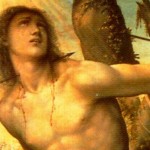The life
 San Sebastiano, by S. Ambrose was born and raised in Milan, father of Narbonne (France) and mother-Milan, had been brought to the Christian faith, he moved to Rome in 270 and began a military career around 283, to become a tribune of the first cohort of the imperial guard in Rome, respected for his loyalty and intelligence by the emperors Diocletian and Maximian, who did not suspect he was a Christian.
San Sebastiano, by S. Ambrose was born and raised in Milan, father of Narbonne (France) and mother-Milan, had been brought to the Christian faith, he moved to Rome in 270 and began a military career around 283, to become a tribune of the first cohort of the imperial guard in Rome, respected for his loyalty and intelligence by the emperors Diocletian and Maximian, who did not suspect he was a Christian.
Due to its function, could help with discretion Christians jailed, take care of the burial of the martyrs and be able to convert military and nobles of the court, where it was introduced by Castulo, home (Parakoimomenos) the imperial family, that he died a martyr. Just when, according to tradition, had buried the holy martyrs Claudius, Castorius, Sinforiano, Nicostrato, called Four Crowned, on via Labicana, was arrested and taken to Maximian Diocletian, which already infuriated by the rumor that spread around, that, in the imperial palace lurked Christians even among the Praetorians, called out the Tribune: "I have always held among the elders of my building and you have operated in the shadows against me, insulting the gods ".
Sebastian was condemned to be pierced by the arrows; tied to a pole in an area of the Palatine hill called 'campus'. Believed dead by soldiers, that had pierced, was left there as food for the wild animals, but the noble Irene, widow of the aforementioned S. Castulo, he went to retrieve the body to bury him, he realized that the Tribune was not dead and trasportatolo in his house on the Palatine, taken to heal the many wounds. Sebastian managed to miraculously heal and then despite the advice of friends to escape from Rome, decided to proclaim his faith again in front of Diocletian and its associated Maximian, while the emperors went to the functions of the temple built by Elagabalus, in honor of Sol Invictus. Heard the reproaches of Sebastian for the persecution of Christians, innocent of the accusations made their, Diocletian ordered that this time was flogged to death; The execution took place in 304 such as. hippodrome of the Palatine, the body was thrown into the Cloaca Maxima, so that Christians could not recover. The abandonment of the bodies of the martyrs unburied, was intended by the pagans as a supreme punishment. The martyr appeared in a dream to the matron Lucina, indicating them the place where she landed the corpse and directing them to bury him in the cemetery "to Catacumbas" on the Appian Way.
Until the sixth century, the pilgrims who came attracted by the 'memory' of the SS. Peter and Paul, the Constantinian basilica erected in memory of the two apostles right above the cemetery, also visited the tomb of the martyr, whose figure was why become very popular and when in 680 was attributed to his intercession, the end of a severe plague in Rome, the martyr s. Sebastiano was elected miracle worker against epidemics and the church began to be called "Basilica Sancti Sebastiani". For his work of assistance to Christians, was proclaimed by Pope S. Caio "defender of the Church". The saint is venerated 20 January is considered the third patron of Rome, after the two Apostles Peter and Paul.
